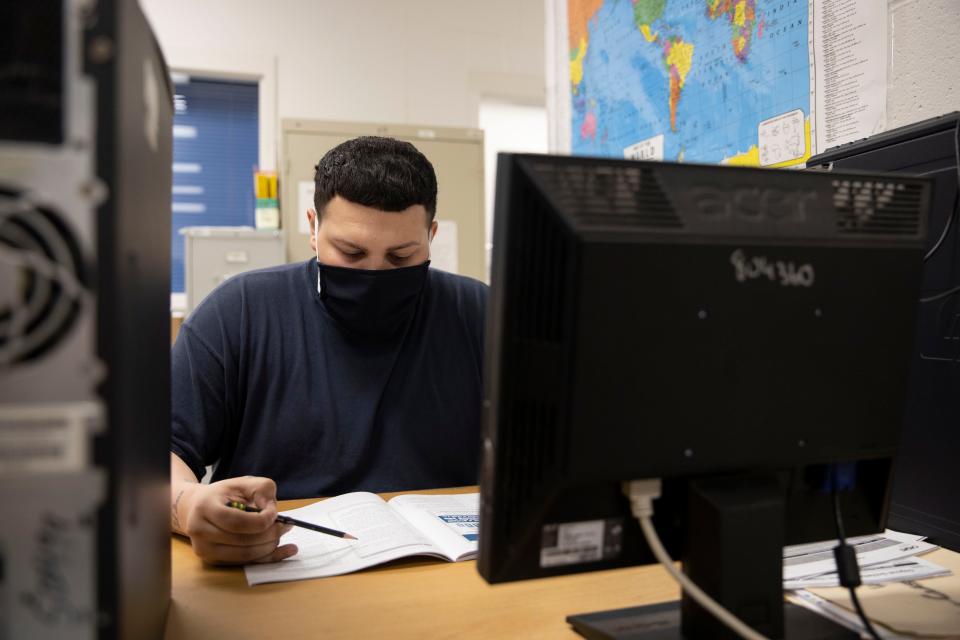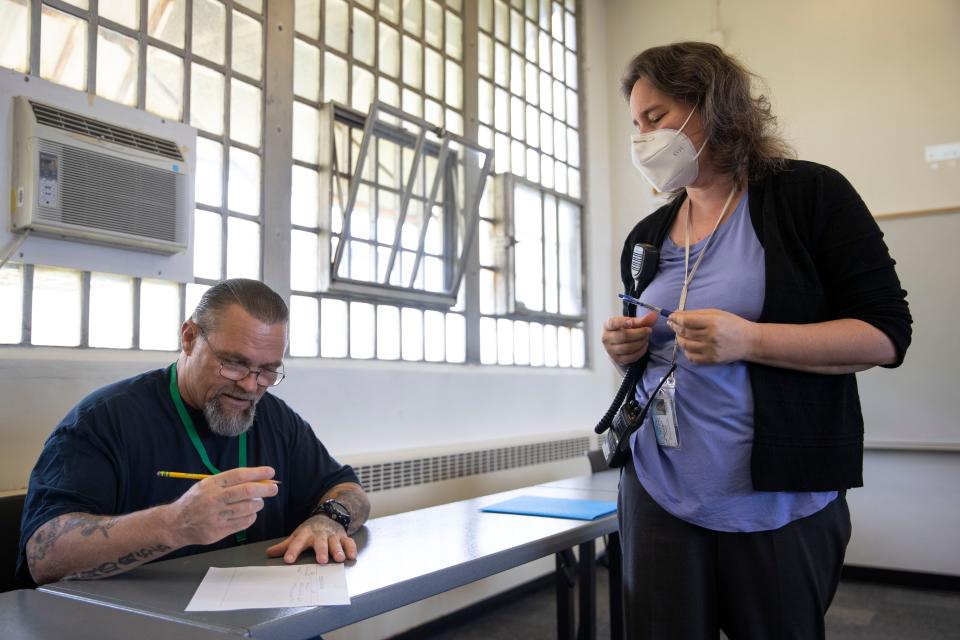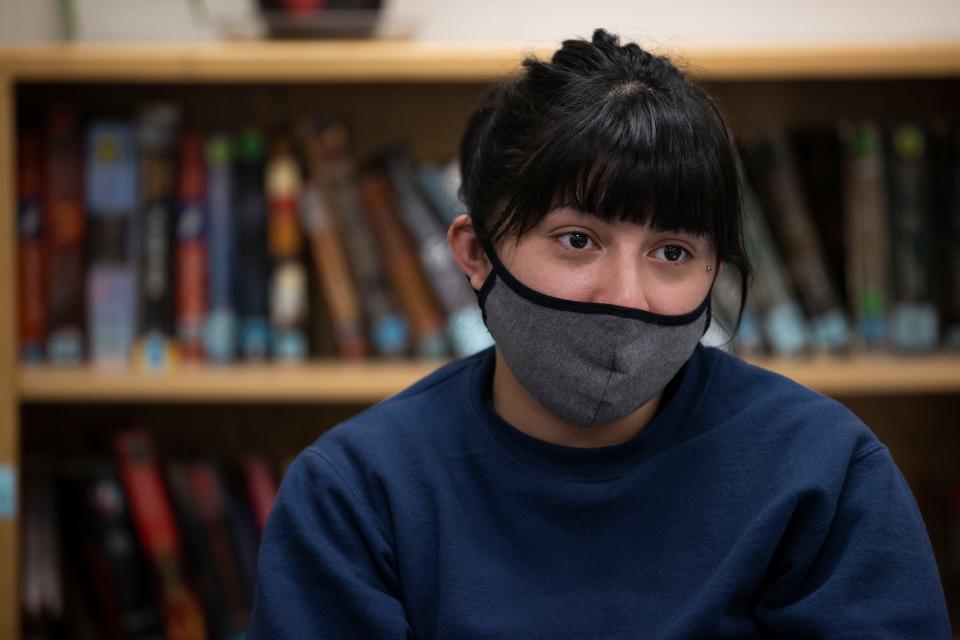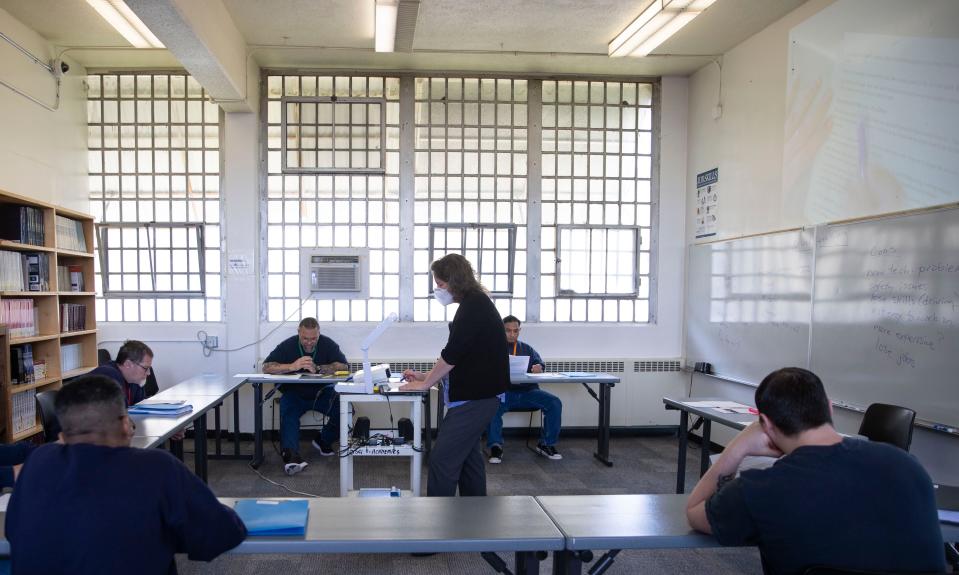The path to prison is often paved by illiteracy. Yet many prisoners aren't being taught to read.
SALEM, Ore. — Vincent Valdez's childhood memories are tinted by the vodka-filled water bottle he brought to class.
“I’ve thrown up a couple of times in the middle of the classroom," he said. "I’ve fallen over on the bus.”
Valdez grew up in what he described as a small Montana mining town. He was enrolled in special education starting in first grade and continuing through middle school. He began drinking around age 10. He barely passed the eighth grade, he said, attributing the accomplishment to his brother helping him complete a report about Yellowstone National Park.
“I’ve always been a slow learner,” he said. “It didn't matter how hard I tried. I would not get it. I can look at a word and, you know, I've seen that word a million times, but I still won't know the definition or how to put it in a sentence or anything like that.”
Valdez said he spent about a week and a half in high school before he got into fights and dropped out. Now 29, he's served prison time in California and Oregon. He's currently at Oregon State Correctional Institution in Salem, working in the kitchen and taking classes. He's scheduled for release within a few years.
His goal is to get his GED and hang it on a wall in his home.

Reading and writing are crucial for navigating everyday tasks. Keeping a job. Learning. Being understood.
A child's ability to read is a key indicator of the likelihood they will graduate high school. Further evidence connects low literacy with the likelihood an individual could end up in prison – and keep returning.
About 15% of adults in Oregon prisons read below an eighth-grade level, an analysis by the Statesman Journal, a part of the USA TODAY Network, found. Nationwide, an estimated 70% or more of incarcerated people can't read at the fourth-grade level.
It's not clear whether Oregon prisoners are actually more literate since there is no state-by-state comparative data or federal oversight.
State law requires the majority of these prisoners take classes while incarcerated. Yet the Statesman Journal found nearly half of Oregon inmates who qualify as low-level readers – those who read below an eighth-grade level – have never been enrolled. And funding and access to these programs are not prioritized. Funding for adult education in Oregon prisons accounts for less than 6% of the Department of Correction’s overall budget.

Prison education advocates are pushing for change in the Legislature. They want more class options, for example, as well as easier access to higher education in and after prison.
There has been little public discussion, however, about how to better serve prisoners who need basic reading and writing skills.
And while the corrections department works with organizations to support parolees upon release with things such as housing and employment, they have no community partnerships to continue parolees' literacy education – despite studies that show specifically helping the low-reader population could have a significant impact on the broader community.
Those who complete educational programs while in prison are less likely to return and are less likely to engage in violence during incarceration. U.S. Department of Justice studies also show the positive impact these programs have when formerly incarcerated individuals return to society, including a higher chance of being gainfully employed.
“A lot of these folks have been in the criminal justice system since they were young children,” said criminal justice reform advocate Julianne Jackson of Salem. “So, those cute little folks that we should have taught to read before? They're adults now. And they still deserve that opportunity. They still deserve the opportunity to do better.”
Illiteracy in prisons
Jeffry Williams said he ran away from home at 13, never having really gone to school. He could barely read or write when he first entered prison in the 1980s.
Williams spent five years in juvenile detention, he said, before entering the adult system as a self-described "notorious gang member." Now 55, he's been in and out for three decades with the longest span outside lasting about five years.
In a class at Oregon State Correctional Institution in May, Williams eagerly read the day's assignment aloud, offering to continue further before popcorning to the next student.
“I get frustrated sometimes and want to walk out, but I don't," he said. "I know it’s helping me.”
Williams is scheduled for release in less than a year, with plans to manage some property, and maybe mentor at-risk youth one day, he said. He wiped tears from under his glasses before lifting his shirt to display his latest tattoo – the name of a grandchild across his stomach.
“I don’t have time for prison anymore,” he said. “I have grandkids I haven’t held yet.”

Prisoners undergo several assessments during the intake process, explained Tracie Hightower, director of education and training for the Oregon Department of Corrections.
These assessments – typically conducted with paper and pencil in the first three days – identify their educational needs and whether they qualify for the state’s Adult Basic Skills Development programming.
Adults who score less than 235 on the reading portion of a test called the Comprehensive Adult Student Assessment Systems, known as CASAS, are assigned mandatory literacy courses. A score of 235 is equivalent to an eighth-grade reading level.
Reliable data on how many adults in prison can read proficiently is hard to discern.
Some complete the test in earnest. Some "pencil whip" it, corrections officials said, randomizing answers to get through quickly. A handful of former inmates told the Statesman Journal they were advised by other prisoners to purposely perform poorly on assessments so they could qualify for more support.
According to CASAS test results, as of mid-June, about 15% of adults in Oregon's prisons read below the eighth-grade level.
Oregon is one of few states that confirms if adults in custody have earned a GED, high school diploma or equivalent. Corrections officials said more than 60% of inmates have a credential, which they say is the inverse of what they've seen from other states.
After receiving the CASAS scores, inmates are assigned to a class. Being assigned does not mean they're enrolled – they could be put on a waitlist first.
The only adults who are exempt from classes are those with developmental disabilities, those who have security or health reasons, or those sentenced to less than a year, to death or life without parole.
If an adult refuses to participate, corrections officials said their privileges, such as yard time or what they can buy from the prison's canteen, are downgraded.
Each facility decides how it structures classes. Many do two hours of classroom time, two hours of one-on-one tutoring and two hours in the computer lab per student per week.
The Department of Corrections partners with Oregon's Higher Education Coordinating Commission and contracts with community colleges to provide the instructors.
For low-level readers, Hightower said, instructors are looking for skills like phonic awareness, decoding, reading fluency, comprehension and vocabulary building – things skilled readers use constantly.
Lessons also are based on the student’s interests, culture and real-life context. There is a focus on daily living skills needed to function both in and outside prison, Hightower explained, including how to navigate DOC documents, medical and dental forms or job applications.
“Many adults have been in DOC custody for so many years that they have no understanding or experience with what an email is, how to send and receive a text message,” Hightower said.
State policy requires students in custody to be retested after receiving between 60 and 100 hours of instruction to measure progress.
The Statesman Journal asked to see data showing how those serving longer sentences progressed in their reading levels. Corrections officials said there was no research on the subject.
"Testing at the beginning of COVID was nonexistent. Then it was completed one at a time, which makes for a slow process since," Hightower said.
She added the information they have now, as a result, doesn't fully represent the last two years.

Each state sets a different bar for how it defines and addresses illiteracy. And there is little to no federal oversight. Data on literacy rates are often outdated or incomplete.
California, for example, requires its prisoners to be assessed upon entry. Prisoners there attend academic programming two hours a day, five days a week.
Of all incarcerated people in California, 8.3% scored below a fourth-grade reading level based on CASAS. The fourth-grade level is used by California corrections to determine class placement, compared to Oregon's eighth-grade level.
In Washington, 56% of tested prisoners scored below the eighth-grade reading level. But unlike Oregon, Washington only tests incarcerated adults after it’s confirmed they don't have a high school diploma or equivalent.
Washington retests prisoners every three to four months to measure progress. Corrections officials said testing and classes have both decreased during the pandemic.
Some comparative data is available through the National Reporting System for Adult Education, tracking Adult Education and Family Literacy Act, or Title II, programs.
But states are only required to report on a set list of outcomes for this, said Sean Addie, director of correctional education for the U.S. Department of Education. And states are not required to use these federal funds for correctional education, so they wouldn't have to report anything if that was the case.
"The short answer (to) what education is available to adults is 'it depends,' " Addie said. "It depends on the state or system and it depends on the individual prison."
Funding for low-level readers
After being suspended from elementary school, Cody Madrid, a prisoner at Snake River, went to another school and did well. He earned mostly Bs and Cs in middle school, he said, and later earned his diploma. In his free time, he likes reading about history.
But Madrid struggles to find text clues and understand what he's read in emails and memos, or detailed instructions – any large chunks of text.
“I just go super quick, then I don't look at it,” he said. “And I get all the wrong answers.”
To pass out of his reading level, Madrid, 23, needs to receive a score of 235 or higher on the CASAS exam. He’s taken the test multiple times, with his highest score, as of June 10, reaching 232.
He expects to be paroled in 2024. He wants to enroll at Portland Community College, then figure out what comes next.
“Take your time,” Madrid offered as advice for others working on their literacy skills. “And if you need any help, ask the question.”

While education programs are crucial for adults in custody, there is limited state funding.
The Oregon Department of Corrections operates on an approximately $2 billion budget per biennium.
The department is responsible for services including addiction and mental health treatment, cognitive-behavioral programming and education.
About $11 million of the department's budget, or about 5.5%, is allocated to adult basic skills development education. There is no funding allocated specifically for low-level readers.
Corrections officials estimated the $11 million covers about $3,000 to $3,500 per student for contracted adult basic education services. With COVID-19, they said, they have served fewer students this biennium than normal.
U.S. Census Bureau data show Oregon's per-pupil spending on K-12 students as of 2021 to be about $12,450 per student.
Some states spent more, such as the California Department of Corrections and Rehabilitation's estimated $176.8 million for "academic adult education," which includes but is not limited to basic literacy programs.
California's prison population is about eight times larger than Oregon's. But state officials would not give a per-pupil estimate.
Barriers to access
Scott “Scottie” Smith is finishing his fourth prison sentence, following juvenile detention throughout his teens. The nearly 30-year-old said he's never stepped foot in a high school.
He didn’t take education inside seriously. His mandatory classes were just a way to pass time, he said, until he started Heather Goldblatt’s basic education course at OSCI in Salem and started to pay attention.
Now, he’s a graduate of that class, working to pass his final two tests before he earns his GED.
He now sees education as the key to getting out and staying out. Smith wants to have an in-person graduation ceremony; he wants to start his own business.
“I used to be a high-wire, like, active gang member out there,” he said. “Now I'm focused on getting all that together.”
Students and educators in corrections face barriers uncommon in the K-12 setting.
Class rosters can change daily or weekly. Class times might not consider students' work schedules or counseling sessions. They may be interrupted if there is a lockdown due to a fight or they have to return to housing units for count. Students are dealing with other issues like gang politics and addiction recovery. Some classes are only available in wards with certain security levels.
As students entered Goldblatt's classroom one morning in May, they each grabbed the blue or black folder with their names on it from a table.
The group of students that day – some of whom have been incarcerated for a matter of months, others for decades – discussed the merits of driverless cars. The words "pros" and "cons" already were written and underlined on the whiteboard. As they debated their initial opinions, Goldblatt transcribed the ideas. They watched a video, read an opinion piece and debated again.
At the end of the class, Goldblatt asked the students to write a paragraph expressing whether they each thought life would be better with driverless cars.
Goldblatt said she adjusts her teaching and materials to fit the varying levels of students. She also works to create an environment in which students are willing to make mistakes, take risks and still feel supported.
"A big part of what creates an 'institutionalized mentality' is the severing of human relationships," Goldblatt said, referring to an idea that incarcerated individuals should keep their heads down and "do their time." "Gray areas or complexities and layers and pros and cons and all those sorts of higher-level thinking skills are pretty challenging to sustain in here.
"They're not encouraged. They're not rewarded. They can get you in trouble."
Goldblatt said she worries most about what happens when her students are released into a world that’s filled with gray. And that's why she's adamant about creating a supportive atmosphere behind the fence.
"Education is almost the only place in the institutions where we can do something different. We are in a classroom, together," she said. "Yes, we're developing literacy skills, which are so important … but almost more importantly, we're keeping those connections to human relations, to a bigger world that's outside of this dreary world that we're in."

Hundreds of Oregon prisoners are waiting to get into these classes.
More than 1,200 prisoners remained on the waitlist for classroom spots as of late June.
Social distancing and other COVID-19 safety requirements are among a long list of reasons for wait times. Resources and available space were cited by Hightower as the primary reasons.
In Washington, its waitlist of more than 1,700 is about the same as the number of students enrolled. Corrections officials there said waitlists have decreased during the pandemic, as the prison population also has decreased.
'They're going to be our neighbors'
Kristina Landrum makes answer keys, grades assignments and works with students on particularly tough subjects as a peer tutor at Coffee Creek Correctional Facility in Wilsonville. She also is known as a "survival coach," helping other adults in prison overcome past traumas and challenges.
A lot can be holding them back, she said. “The fear of failure, fear of the unknown, fear they can’t get something right. It’s a crippling fear."
Landrum recalled the moment one of her students, a 21-year-old who “literally didn't know how to read,” told Landrum she wanted to read Harry Potter aloud.
Landrum beamed, saying the student within three years not only read Harry Potter but got her GED and earned a coveted work placement at the prison.
“Education opens doors after, but it also opens doors in here,” she said. “It’s all about learning things that help you cope and move past those things that have been burdening you.”
Prison literacy efforts, along with larger education programs, play a large role in reducing the rate of violent interactions within prisons. They also help break the cycle of crime.
A 2013 study found that incarcerated individuals who participate in correctional education programs are 43% less likely to recidivate.
“Ninety-five percent of people in custody are getting out again,” said Michele Deitch, a senior lecturer at the University of Texas at Austin and the director of the school's Prison and Jail Innovation Lab.
By investing in prison education, people who are incarcerated come out better than when they went in, she said.
"We're all safer as a result," she said. “They're going to be our neighbors. They're going to be the people we work with. They're going to be the people we sit next to in movie theaters or in restaurants."
These efforts also contribute to improving the communities to which they return.
It's estimated limited literacy skills cost businesses and taxpayers more than $20 billion annually in lost wages, profits and productivity. And according to research from George Washington University, investing in these programs could save some $238 billion annually in health care costs alone.
The impact of these investments also lasts for multiple generations. Statistics cited by the Mid-Valley Literacy Center in Salem show that for every dollar invested in adult literacy programs, it returns $33 to the local economy.
"Adults with more education are able to obtain employment, earn higher wages, pay taxes and reduce dependence on public assistance," said Vivian Ang, executive director of the local center. "This is the kicker: (Their) children perform at higher levels in school and their graduation rates increase."
Jackson, an advocate in Salem, was released from a juvenile facility when she was about 17. She said education was not prioritized during her incarceration.
“You're automatically seen as, like, an issue that needs to be dealt with and not as a child that has potential or is potentially smarter than they're giving you credit for,” she said.
Jackson said her issues began in school when she was disciplined for behaviors that she now realizes were a response to abuse and trauma.

She participates in local school board meetings and protests to eliminate what’s known as the school-to-prison pipeline, which highlights the fact that students of color, students from low-income households and students with disabilities are disproportionately likely to be given suspensions and expulsions, have school-related arrests and be put into juvenile detention.
Taking education away from children and incarcerated people doesn't work, Jackson said.
"Education offers humanity," she said. "When I did get my GED and somebody told me I was smart? Oh, man, it opened up a whole world to me."
That speaks to the emotional impact these programs also have on the individuals involved, including those serving life sentences.
"We all have those thresholds that we don't see ourselves going beyond," said Kevin Bradley, the corrections education director for Portland Community College. But learning in prison allows these adults to "enter a world they thought was closed to them."
"It cancels a lie that they've lived with – for some of them, for many, many years — that they would never be able to do it," Bradley said. "It's a vehicle to teach a person that they can grow, and they can change."
Introducing Reading Horizons
Mark Dean placed headphones over one ear and listened as a computerized voice chimed three-letter words for him to spell. Dean typed “dag” and “bab” as he half-listened, half-explained how he uses the Reading Horizons program.
Dean is serving more than 50 years to life. He was in the mental health ward of the maximum-security California State Prison in Los Angeles County in May. His goal is to get his high school diploma or equivalent, and then enroll in college.
“It’ll keep me from getting into trouble,” he said, adding he wants to prove he’s no longer a threat to himself or others.
Dean, 52, said he was kicked out of school in the 10th grade when he started “making the wrong decisions.”
“I can’t do nothing about it, but I can change,” he said.
Resources available in prison allow students like him to focus on education in a way they couldn't outside.
“I’ve got a lot of time on my hands,” he said. “I'm tired of being in prison, of being locked up. I want my freedom back.”
Oregon is on the verge of implementing a new literacy program that could help low-level readers.
Reading Horizons, a primarily online program, will be used in addition to classes and tutoring in Oregon prisons, all overseen by an educator. The supplemental program is used in juvenile and adult correctional facilities in nearly two dozen states, including California.
The California Literacy Project studied the impact of the program over three years. In the study, 40% gained more than three and a half grade levels in their reading skills.
The Oregon DOC plans to implement the curriculum across the state as early as this summer, tapping into $13,750 annually from the state's federal Individuals with Disabilities Education Act money.
Instructors told the Statesman Journal they don’t want the online component to take away from person-to-person interactions in the classroom. And Hightower doesn’t expect the program will change the state's waitlist.
But proponents said it can provide a needed individualized approach.
Oregon's Hightower said, “(Reading Horizons) will enable us to encourage more to enroll because it provides anonymity and removes the often-embarrassing stigma associated with illiteracy.”
Looking for solutions
Jasmine Herrera, an inmate working toward her GED at Coffee Creek, said she was in school until ninth grade. She was a straight-A student but bullied to the point she dropped out.
“It took over my whole self-esteem,” she said. “I was pretty good, until I wasn’t.”
Getting her education – “even if it’s in here” – is important to Herrera.
Staffers said some people assume a GED earned in prison is somehow less legitimate than a "normal" GED, but that's not the case.
“I know it’s important to me, but I don’t know why,” Herrera said. “It’s an accomplishment, and I don’t have many of those.”

Formerly incarcerated individuals are fighting for more education options in and after prison. Advocates also want to establish partnerships with the DOC to continue that work upon release.
"The system is supposed to work like this: You commit your crime, you do your time and you're done," Jackson said. "And unfortunately, that's not the way that it works.
"We know that people who have felonies are not even eligible for student loans. They're not eligible for any type of government assistance to go to school. And again, we know that these are determinants for criminality."
Much of the work impacting prison education is happening at the state legislative level.
In 2007, Oregon lawmakers passed Senate Bill 189, which established the primary objective of the Department of Corrections' education system: Focus on adult basic skills development "rather than just functional literacy." The focus since has been on areas other than literacy. Senate Bill 23, for example, helps inmates with financial aid options while Senate Bill 1522 gets more equipment and technology for students at Coffee Creek and Snake River facilities.
Washington lawmakers recently passed a bill to establish a process for identifying and assessing incarcerated people with learning disabilities, traumatic brain injuries and other cognitive impairments to determine whether they need accommodations to effectively participate in educational programming.

Advocates like Ang with the Mid-Valley Literacy Center are focusing on bridging the gap in services.
Ang said the center has worked with people coming from Marion County Jail and Marion County Adult Drug Court.
Ang wants parolees to know there are no barriers to working with the center. If an adult who's been released needed additional support or wanted to tutor at the center, there is no reason they couldn't, she said. The center has scholarships for students, too.
Corrections officials said they would help a parolee looking for additional education upon release, if requested.
Corrections could provide information to organizations about the individual's education progress, test scores and references, for example. Hightower said they do not make referrals.
Inmates are provided information on where they could continue their education once released from custody, but once they leave, they are no longer under corrections' supervision.
Ang says ensuring this kind of work continues is crucial.
"If we're going to address homelessness and hunger, we have got to address literacy," she said. "We're never going to reduce recidivism if we do not address literacy."

This project was completed thanks to funding via a fellowship with the Education Writers Association.
Follow Natalie Pate on Twitter: @NataliePateGwin.
This article originally appeared on Salem Statesman Journal: Literacy issues: Prisoners who need reading help don't get it


